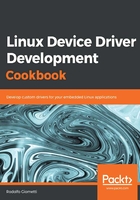
Getting ready
In this book, I will use an Ubuntu 18.04 LTS based system but you can decide to try to replicate some settings and installation commands that we will use during the course of this book into another major Linux distribution, with little effort for a Debian derivative, or in a bit more of a complicated manner in the case of non-Debian derivative distributions.
I'm not going to show how to install a fresh Ubuntu system on a PC nor on a virtualized machine since it's a really easy task for a real programmer; however, as the last step of this chapter (the Doing native compiling on foreign hardware recipe), I will introduce, with detailed steps about how to install it, an interesting cross-platform environment that proved useful to compile foreign target code on the host machine as we were on the target. This procedure is very useful when we need several different OSes running on your development PC.
So, at this point, the reader should have their own PC running (natively or virtualized) a fresh installed Ubuntu 18.04 LTS OS.
The main usage of a host PC is to edit and then cross-compile our new device drivers and to manage our target device via the serial console, to create its root filesystem, and so on.
In order to do it properly, we need some basic tools; some of them are general while others depend on the specific platform onto which we are going to write our drivers.
General tools are surely an editor, a version control system, and a compiler and its related components, while specific platform tools are essentially the cross-compiler and its related components (on some platforms we may need additional tools but our mileage may vary and, in any case, each manufacturer will give us all of the needed requirements for a comfortable compilation environment).
About the editor: I'm not going to spend any words on it because the reader can use whatever they want (regarding myself, for example, I'm still programming with vi editor) but regarding others tools, I'll have to be more specific.